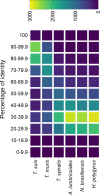Rodent Models for the Study of Soil-Transmitted Helminths: A Proteomics Approach
- PMID: 33968800
- PMCID: PMC8100317
- DOI: 10.3389/fcimb.2021.639573
Rodent Models for the Study of Soil-Transmitted Helminths: A Proteomics Approach
Abstract
Soil-transmitted helminths (STH) affect hundreds of millions worldwide and are some of the most important neglected tropical diseases in terms of morbidity. Due to the difficulty in studying STH human infections, rodent models have become increasingly used, mainly because of their similarities in life cycle. Ascaris suum and Trichuris muris have been proven appropriate and low maintenance models for the study of ascariasis and trichuriasis. In the case of hookworms, despite most of the murine models do not fully reproduce the life cycle of Necator americanus, their proteomic similarity makes them highly suitable for the development of novel vaccine candidates and for the study of hookworm biological features. Furthermore, these models have been helpful in elucidating some basic aspects of our immune system, and are currently being used by numerous researchers to develop novel molecules with immunomodulatory proteins. Herein we review the similarities in the proteomic composition between Nippostrongylus brasiliensis, Heligmosomoides polygyrus bakeri and Trichuris muris and their respective human counterpart with a focus on the vaccine candidates and immunomodulatory proteins being currently studied.
Keywords: Heligmosomoides polygyrus; Nippostrongylus brasiliensis; Trichuris muris; host-parasite interactions; immunomodulation; proteomics; soil-transmitted helminths (STHs); vaccines.
Copyright © 2021 Montaño, Cuéllar and Sotillo.
Conflict of interest statement
The authors declare that the research was conducted in the absence of any commercial or financial relationships that could be construed as a potential conflict of interest.
Figures




References
Publication types
MeSH terms
Substances
LinkOut - more resources
Full Text Sources

